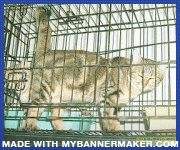Berikut adalah sedikit fakta tentang baka New Zealand White. Diharap dapat memberi sedikit info kepada sahabat-sahabat sekelian.
New Zealand white rabbits are a breed of rabbit, which despite the name, are American in origin. In 1916, W.S. Preshaw bred the first litter of New Zealand white rabbits with a plan to produce a rabbit that would be excellent for meat and fur trade. The original breeds that were used are unknown, but Angoras are believed to have played some part. (Verhallen 23-35)
Physiology
New Zealand white rabbits were bred for their meat and fur, but their body type helped to contribute to them becoming the favorite breed of domestic rabbit. New Zealand whites have well-rounded bodies; slender and muscular faces with round cheeks; large, long back feet; and small, short front feet (Rubins). They have long perforrated ears that stand straight up. Unlike the thick, snowy fur on their bodies, their ears have shorter fur that allows the delicate pale pink of their skin to show through (Rubins). The most noticeable characteristic of New Zealand white rabbits is their bright eyes, which range in shade from pale pink to bright ruby red (Rubins).
New Zealand white rabbits have large, broad, and muscular bodies. Bucks (males) weigh between 8-10 pounds, while the does (females) weigh between 9-12 pounds (Verhallen 23-35). In addition to their greater size, females are distinguished by the presence of a dewlap, which is flap of fur below the chin that is pulled for a nesting box during pregnancies.
Albinism
New Zealand white rabbits have a genetic deviation called albinism. Albinism is caused by a lack of melanin, which is a vital pigment that gives all creatures, including humans, their skin/ fur/ hair/ eye color. The snowy coat of a New Zealand white rabbit is a normal length like other rabbit breeds.
Diet
The diet of a New Zealand white rabbit is no different than for any of other rabbit breeds. A high quality feed pellet (protein ~ 15-16%), along with unlimited timothy hay and fresh water and exercise will maintain a healthy individual.
Domestic use
In the beginning New Zealand white rabbits were not bred to be a domestic pet. Instead they were bred for their excellent fur and meat. Fryers are slaughtered at two months of age and older rabbits are sold as roasters. The rabbits with high grades of fur are used to make fur coats and fur trimmings. The lower grades are used to make felt hats and glove linings ("Commercial Rabbit Raising"). New Zealand white rabbits are the number one meat rabbit in the United States (Bare 63-65).
Along with commercial purposes, New Zealand white rabbits are also used for laboratory purposes. Over one million New Zealand white rabbits execute roles during laboratory testing. Rabbits react similarly to humans to diseases and medications. This reaction allows them to be used at pharmaceutical laboratories, the U.S. Public Health building, cancer research centers, and university hospitals. New Zealand white rabbits have been used to develop tests and drugs for diseases like diabetes, diphtheria, tuberculosis, cancer, and heart disease. The effects of skin creams, cosmetics, special diets, and food additives have also been tested on New Zealand white rabbits. (Bare 63-65)
Breeding
A female rabbit (doe) is fertile all year long. The gestation period is around 28–31 days. A few days before birth, a nest box should be provided for the new mother. The doe will pull fur from her dewlap and, along with hay or other materials provided, will create a nest. The young are called kittens and are born hairless with their eyes closed. Fur begins to grow in by day 5 or 6 and after 10 to 12 days the kits' eyes will open. At the age of three weeks their mother will begin to wean them off milk, meanwhile the kits will begin to eat hay and pellets. The average number of kits per litter is six but can range from two to twelve. Because rabbits are induced ovulators a doe can become pregnant by the simple act of mating if conditions are right. A doe can get pregnant soon after birth.
Cannibalism is rare but can happen. In the wild it is a defensive mechanism to remove all blood and dead tissue from the nesting area to avoid detection by predators. If young are stillborn or die after birth, many times the doe will ingest the remains. Males (bucks) rabbits have no part in raising the young. In the wild, bucks will kill litters to induce the female to mate with them, therefore passing along his genes. (Rabbit Production, Cheeke et al.)
New Zealand Whites are popular rabbits as pets, in the show ring, and unfortunately in the laboratory and meat/fur farm. New Zealand White Rabbits are easily distinguished by their relatively large and solid bodies covered in dense white fur, their upstanding white ears, and their red eyes. New Zealand Whites have become the poster child of the Easter Season, and are often depicted as being the Easter Bunny.
The name "New Zealand White" is a bit of a misnomer however, as New Zealand Whites were originally bred in America. They were destined for the meat and fur trade even at their inception, and fate has not been much kinder with their widespread use in laboratories. However, as with many animals bred to be slaughtered or tested on, the New Zealand White Rabbit has a cheerful and friendly disposition. They are affectionate, intelligent, and one of the easier breeds to teach tricks. These factors make the New Zealand White an ideal pet choice, as unlike many of the other rabbit breeds, they are less likely to be standoffish and aggressive.
How big will they get ?
Generally New Zealand White Rabbits grow to the following sizes:
Buck: 4 - 5 kgs / 9 - 11 lbs
Doe: 4.5 - 5.5 kgs / 10 - 12 lbs
If you are interested in showing your New Zealand White Rabbit, here are some of the characteristics you should be looking for:
Head: Should be strong and muscular looking, but should not be out of proportion with the rest of the body. The neck should not be long, in fact, a non-existent looking neck is highly regarded in the New Zealand White Rabbit. Those little red eyes should be bright and alert, and should be a nice deep red, and the ears should stand erect.
Body: The New Zealand White should have a broad and muscular body, well shaped, with large, long back feet and short front feet. There should be plenty of 'meat on the bones', though this should not tip over into sloppy heaviness. The toenails should be either white or flesh colored. The fur should be nice and dense, and should be a lovely white color. It should not be too soft, but have a stiffness to it. If your rabbit is moulting, it is not a good time to show him or her.
Faults: It is not considered positive if a New Zealand White is too long, or too short in the body, has fur that is woolly or stained, or that tends towards a yellowy cream color rather than white. Long narrow heads also find disfavor, as do ears that don't stand nicely erect.
Showing rabbits can be a lot of fun, but even if your New Zealand White isn't a champion, they are sure to be a delightful pet and a quiet and gentle companion.















Dear Sir
ReplyDeleteI would like to order New Zealand White Rabbits. Do you ship to Sandakan, SAbah?
Email me at my facebook page: 'Lynnfield Pride'
Thanks
Craig